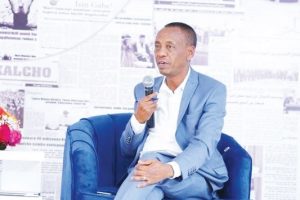
BY GETACHEW MINAS
The UN thrives on the potential and actual atrocities committed anywhere in the world. Mayhems are like festivities for UN staff, travelling to and back from conflict areas, particularly in the developing countries like Ethiopia. For the UN experts at the Headquarters, it is like holiday or break from the monotony of irrelevance, sitting in well-furnished offices located at skyscrapers.
They constantly look for evidences of ethnic, tribal and indigenous skirmishes through their offices located in the developing countries. They tend to forget that these scuffles, clashes and conflicts are natural in traditional societies. However, they interfere through their local agents or employees in the internal affairs of the local people. They report on petty incidents that may go out of control through instigation and misinformation, using their own media. This is done to justify their presence in a developing country which they want to remain poorer.
Poverty is one of the justifications for a UN presence in developing countries. Where there is poverty, it is expected to have social unrest for which the international agency is ready to send a peace-keeping mission for subduing the poor natives involved in normal local conflicts. Petty local conflicts are immensely magnified to justify external and unnecessary interference.
The first step is food aid for conflict affected parts of a country. This aid keeps people in a cycle of dependency and worsened poverty. As people become poorer they expect assistance even from the “devil” that caused their impoverishment. The evil comes in with grain that may not be used for planting. This kills the little effort and motive of a peasant to keep himself self-sufficient. As the numbers of aid dependents increase the burden on the government becomes heavy.
Aid givers come with their hidden conditional ties to which the government has to subdue. The ties become stronger as aid dependents increase in number. One of the ties is policy directives which the poor country has to adopt respectfully. Any omission leads to a loss of programed assistance. This may lead to chaos and unrest as hungry people run out of food aid. Aid giving is a two-pronged approach.
In the first one, the recipient has to completely and entirely submit to the directives and strategies of the donor. The donor prepared document of submission is signed and approved by the head of an agency responsible for distribution of aid to the so-called needy in the land of plenty. The second approach is to ensure a vicious circle of underdevelopment in the recipient country. Impoverished people are bound to depend on aid rather than stand together to fight imposed poverty. This imposition is masked with aid. It keeps people away from hard work and self-sustenance.
The reason behind aid is to keep people of the developing countries even more impoverished. This prevents people from developing their own natural resources. These resources have to be exploited by the developed world for the purpose of maintaining the standard of living of the rich citizens of the West.
Any attempt by a third world politician, economist or technical persons to use these resources for the benefit of the poor people has to be stricken out preemptively. This measure includes elimination of leaders and proponents of the economic and social development of their poor countries.
Another hidden strategy, as mentioned earlier, is to keep people in poverty with external aid. The latter is a peaceful looking approach with the same end as the aggressive one. Both strategies are designed to exploit natural resources of poor countries. Foreign investors are the instruments of exploitation of the developing countries. These investors are given the best treatment by the recipient countries just to secure temporary relief.
There is a wild competition among these countries to attract these investors with all kinds of advantages including tax holidays for a given number of years. The leaders of these countries are enticed by the foreign investors in different ways. They become shareholders in the exploitation of their own countries at the expense of the impoverished people. The incomes they acquired are kept in safe havens abroad through the intermediary of the foreign evil. In the newly independent countries, both domestic rulers and external investors agree to achieve high profitably at the expense of the poor.
International agencies that are supposed to assist the poor developing countries collect all the necessary information on the political, economic and social conditions in these countries. They conduct assessment of situations that may be conducive for foreign investors. These agencies wear different masks for varying situations and try to control developments.
Political situations change with realities on the ground. Concerned institutions also adjust to these changes, using and applying sensors that identify actors, both domestic and foreign. These institutions come under the guidance of superpowers that plan to dominate and control resources of poor countries, using agents. These agents are financed by those powers that have the intention of exploiting resources in collaboration with local agents. The point of entrance is “development aid” to alleviate poverty in the developing countries. Once these agents are planted, their role is to gather all kinds of information for analysis by officials at the Headquarters. The analytical reports mostly suggest the provision of further assistance to the poor countries. In other words, deeper analyses have to be conducted for ways and means of exploitation.
Local individuals within key institutions are identified as key contacts. These individuals are, if necessary, attracted to the avenue of benefits, paybacks and remuneration based on their performance. They are given guidelines for their assignments in addition to their official duties. These duties are excellent cover for their missions of serving the interest of alien bodies. They are remunerated further depending on their activities that are in line with policies and strategies of alien agents.
Remunerations depend on actual and “potential atrocities” committed by foreign and local collaborators on the government of a country like Ethiopia. These atrocities take different shapes in various situations. Anarchism and lack of law and order is one element that ensures the domination of Ethiopia by groups appearing in different missions, both political and social. They apply economic sabotage for guaranteeing anarchism, disorder, chaos, mayhem in different parts of the Ethiopian economy and society.
The International Commission of Human Rights Experts on Ethiopia chaired by Kaari Betty Murungi and Commission Member Steven Ratner delivered a statement on Ethiopia in Geneva on 19 September, 2022. Civilians in northern Ethiopia are at risk of further atrocity crimes as renewed conflict again plunges the country into crisis.This warning came as the Commission of Human Rights Experts on Ethiopia, established by the UN Human Rights Council in December 2021, published a report.
The report concludes that there are reasonable grounds to believe that parties to the conflict have committed war crimes and violations and abuses of human rights since fighting erupted in November 2020. Lacking fairness and taking sides with the TPLF junta, the Murungi commission further concluded that there are “reasonable grounds” to believe that the government and its allies have committed crimes against humanity. However, it failed to specify the allies in these acts.
The report goes on to highlight the situation in Tigray, where the government and allies have denied around six million people access to basic services, including internet, telecommunications, and banking services for over a year. The report has “not” included the views of the government on this issue. Yet, the report reveals the prejudice of HR experts toward the Ethiopian government, with its reference to “severe” restrictions on humanitarian access to Tigray, leaving 90% of the population in dire need of assistance.
What are the measurements of severity “without” even referring to the worst HR crises committed by the TPLF in the Amhara and Afar Regions? Murungi, as chair of the Commission, says that “The humanitarian crisis in Tigray is shocking, both in terms of scale and duration.” She continues saying without any shame and reservation that: “The widespread denial and obstruction of access to basic services, food, healthcare, and humanitarian assistance is having a devastating impact on the civilian population.”
In fact, the government of Ethiopia has been supplying basic services, food, healthcare and other humanitarian assistance. Murungi goes on exposing herself saying that she has reasonable grounds to believe that the government action amounts to a “crime against humanity.” She also has “reasonable grounds to believe that the Federal Government is using starvation as a method of warfare.” She assertively writes with her colleagues dictating that “The Federal Government should immediately restore basic services, and ensure full and unfettered humanitarian access.
Tigrayan forces should ensure that humanitarian agencies are able to operate without impediment,” Murungi added. But, she never uttered a word about the diversion of humanitarian assistance by the TPLF to its fighting forces. This force is composed of very young people that are “not” allowed by the UN to fight in the battle fronts because of their low age.
Murungi never referred to the starvation method of warfare applied by the TPLF in its attack against the poor peasants in the Amhara and Afar Regions. Even worse strategies have been used by the TPLF against those peasants, who have been forced to watch their women and girls raped, families burnt in huts, churches and mosques destroyed and cattle and harvest burned, the government defense forces murdered after invitation for dinner provided by the TPLF junta, infrastructure, thousands of schools, health centers and hospitals have all been destroyed.
These are only a small part of the crimes committed by the TPLF against the people in its neighboring regions. Yet, Murungi never reported the whole of the atrocities committed by the TPLF. She misreported on the role played by the Ethiopian Air Force that struck only TPLF military camps, which she confused with camps for internally displaced persons. She has also misidentified airstrikes against the TPLF forces as having impacted civilians or civilian objects and demanded further investigation. Her demand for further investigation is tantamount to admitting her failure in having the true and holistic and complete picture of atrocities committed.
Murungi’s assistant theorized on the use of drones for more precise targeting of military objectives. But, the commission’s investigation indicates that their use has exposed civilians to new and heightened risks. Their findings are focused on airstrikes in Tigray since August, which have killed and injured civilians, including children. However, the stark reality showed the crimes committed by the TPLF and this forced the commission to swallow the hard pill of truth. Consequently, it reported that the Tigrayan forces have also committed war crimes and human rights abuses, including large-scale killings of Amhara civilians, rape and sexual violence.
It also reported on the widespread looting and destruction of civilian property in Kobo and Chenna in August and September 2021. To save its skin, the commission also reported that large-scale killings are not just confined to Amhara and Tigray only but is also spread to Oromia that led it to conclude “normalization of extreme violence is deeply disturbing.” Here again the commission is not clear on the agents and victims of violence. This shows the hidden motive of the whole exercise of the commission. Probably, its mission may end up in engendering the “Potential for Atrocities.” It is noted that the report is incomplete and, therefore, misleading, causing further damage to Ethiopians.
Editor’s Note: The views entertained in this article do not necessarily reflect the stance of The Ethiopian Herald
The Ethiopian Herald September 30/2022




